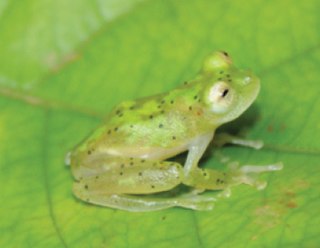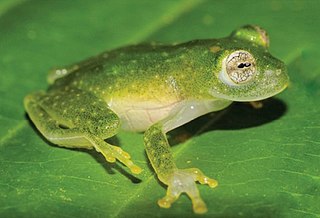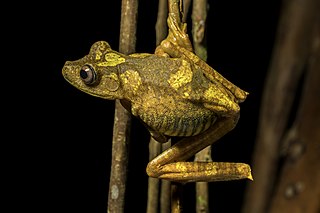Werner's toad is a species of toad in the family Bufonidae. It is found in northwestern Guyana and eastern Venezuela at elevations of 500–1,350 m (1,640–4,430 ft) asl.

Amazophrynella minuta is a species of toad in the family Bufonidae. It is found in Bolivia, Brazil, Colombia, Ecuador, French Guiana, Guyana, Peru, Suriname, and Venezuela. However, because of the poor description of new Amazophrynella species, it is not clear which old records refer to this species and which records refer to the new species.
Vitreorana gorzulae is a species of frog in the family Centrolenidae. It is found in Bolívar state in Venezuela and in Guyana. In Spanish it is known as ranita de cristal de Gorzula. Its natural habitats are subtropical or tropical moist montane forests, rivers, and intermittent rivers.
Vitreorana helenae is a species of frog in the family Centrolenidae. Two common names are sometimes used to refer to this species: Venezuelan glass frog and Helena's glass frog. In Spanish, it is locally known as ranita de cristal de Helena.

Hyalinobatrachium iaspidiense is a species of frog in the family Centrolenidae from South America. Its specific name refers Quebrada de Jaspe, its type locality.

Hyalinobatrachium taylori is a species of frog in the family Centrolenidae. Its common name is Taylor's glass frog, and in Spanish, ranita de cristal de Taylor. It may represent at least two distinct species.
Warren's tree frog is a species of frog in the family Hylidae found in Guyana and possibly Brazil and Venezuela. Its natural habitats are subtropical or tropical moist montane forests, rivers, freshwater marshes, and intermittent freshwater marshes.

The map tree frog is a species of frog in the family Hylidae found in Bolivia, Brazil, Colombia, Ecuador, French Guiana, Guyana, Peru, Suriname, Trinidad and Tobago, and Venezuela. Its natural habitats are subtropical or tropical dry forests, subtropical or tropical moist lowland forests, moist savanna, subtropical or tropical seasonally wet or flooded lowland grassland, rivers, freshwater lakes, intermittent freshwater lakes, freshwater marshes, plantations, rural gardens, heavily degraded former forests, ponds, and aquaculture ponds. It was previously known as Hyla geographica. The name comes from the reticulated map-like patterns on its eyelids (palpebrum). The black tadpoles congregate in dense clusters in ponds or other calm waters.
Hoogmoed's tree frog is a species of frog in the family Hylidae found in Guyana, possibly Brazil, and possibly Venezuela. Its natural habitats are subtropical or tropical moist montane forests and rivers.
The La Escalera tree frog is a species of frog in the family Hylidae found in Guyana, Venezuela, and possibly Brazil. Its natural habitats are subtropical or tropical moist lowland forests, subtropical or tropical moist montane forests, rivers, and freshwater marshes.
Nesorohyla is a monotypic genus of frogs in the family Hylidae. The sole species is Nesorohyla kanaima, also known as the Kanaima treefrog. It is endemic to Guyana. and possibly Brazil and Venezuela. Its natural habitats are subtropical or tropical moist lowland forests, subtropical or tropical moist montane forests, and rivers.

The Manaus slender-legged tree frog, also known as the giant broad-headed tree frog, is a species of frog in the family Hylidae found in Bolivia, Brazil, Colombia, Ecuador, French Guiana, Guyana, Peru, Suriname, and Venezuela. Its natural habitats are subtropical or tropical dry forest, subtropical or tropical moist lowland forest, moist savanna, rivers, intermittent freshwater marshes, and canals and ditches. It is threatened by habitat loss. It is also reported to produce Bufotenin.

Adenomera andreae is a species of frog in the family Leptodactylidae.
Stefania ackawaio is a species of frog in the family Hemiphractidae. It is endemic to Guyana. Its natural habitat is subtropical or tropical moist montane forests.
Stefania ayangannae is a species of frog in the family Hemiphractidae. It is endemic to Guyana where it is known from Mount Ayanganna and Mount Wokomung, both in the Pacaraima Mountains.
Stefania coxi is a species of frog in the family Hemiphractidae. It is endemic to Guyana and has been found on Mount Ayanganna and Mount Wokomung. Its natural habitat is subtropical or tropical moist montane forests at higher elevations.
Otophryne robusta is a species of frog in the family Microhylidae. It is found in Guyana, Venezuela, and possibly Brazil. Its natural habitats are tropical moist montane forests and rivers. It is threatened by habitat loss.
The Arrabal's Suriname toad is a species of frog in the family Pipidae found in Brazil, Guyana, Suriname, Venezuela, and possibly Peru. Its natural habitats are subtropical or tropical moist lowland forests, freshwater marshes, intermittent freshwater marshes, ponds, and canals and ditches. It is threatened by habitat loss.
Rhinatrema nigrum, the black caecilian, is a species of caecilian in the family Rhinatrematidae found in Guyana, Venezuela, and possibly Brazil. Its natural habitats are subtropical or tropical moist lowland forests, subtropical or tropical moist montane forests, rivers, and intermittent rivers.

Adelophryne patamona is a species of frog in the family Eleutherodactylidae. It is endemic to the Pacaraima Mountains of southwestern Guyana, although it is likely to also occur in the adjacent Roraima state of Brazil. It is most closely related to A. gutturosa.







